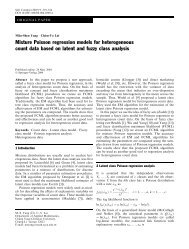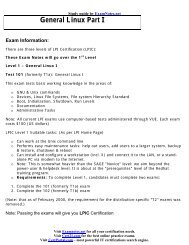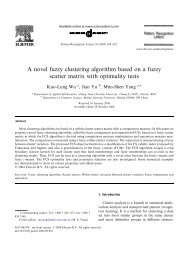A control chart pattern recognition system using a statistical ...
A control chart pattern recognition system using a statistical ...
A control chart pattern recognition system using a statistical ...
Create successful ePaper yourself
Turn your PDF publications into a flip-book with our unique Google optimized e-Paper software.
206<br />
J.-H. Yang, M.-S. Yang / Computers & Industrial Engineering 48 (2005) 205–221<br />
for monitoring variations in the product manufacturing process. However, these <strong>control</strong> <strong>chart</strong>s do not<br />
provide <strong>pattern</strong>-related information because they focus only on the latest plotted data points. In other<br />
words, only the last point on the <strong>chart</strong> is examined rather than the trend in the process over time.<br />
The value of average run length (ARL) is usually used to measure the frequency before the process is<br />
out-of-<strong>control</strong>. ARL is generally defined as the average number of points in a <strong>control</strong> <strong>chart</strong> until an out-of<strong>control</strong><br />
signal occurs. Under a normal distribution N(m,s 2 ) assumption with its mean m and variance s 2 ,it<br />
is called out-of-<strong>control</strong> when its value is outside the range of G3s from the mean m. In general, it is<br />
unavoidable due to a random noise even though in a regular condition. For example, when we have a<br />
production process that the quality of products is under the N(0,1) assumption, the probability P(X%K3<br />
or XR3)Z0.0027 such that 1/0.0027z370.4. Thus, ARL under the N(0,1) assumption is around 370.4.<br />
Similarly, for mZ0.5 with s 2 Z1, ARL is around 155.2. The ARL value for other mean shift m with s 2 Z1<br />
is shown in Table 1. We can see that ARL will be decreasing when a mean shift m is increasing. We know<br />
that the smaller ARL exhibits out-of-<strong>control</strong> signal more often. In this case, it is not good for detecting<br />
abnormal process behavior with a Shewhart <strong>control</strong> <strong>chart</strong> because it is variable due to a mean shift m.<br />
Therefore, the <strong>control</strong> <strong>chart</strong> <strong>pattern</strong> <strong>recognition</strong> is important for recognizing unnatural <strong>pattern</strong>s in <strong>control</strong><br />
<strong>chart</strong>s.<br />
Control <strong>chart</strong> <strong>pattern</strong> <strong>recognition</strong> has the capability to recognize unnatural <strong>pattern</strong>s. In general,<br />
there are six unnatural <strong>pattern</strong>s in <strong>control</strong> <strong>chart</strong>s. They are upward trend, downward trend, upward<br />
shift, downward shift, cycle and <strong>system</strong>atic variation. These <strong>pattern</strong>s present the long-term behavior<br />
of a process. If any of these <strong>pattern</strong>s appears, something has occurred in the process such as a<br />
change of raw materials, equipment damage or the state of workers. If we can have such<br />
information on hand and then make decisions on the process, it will help us prevent failures<br />
appearing in the future.<br />
There have been many studies on <strong>control</strong> <strong>chart</strong> <strong>pattern</strong> <strong>recognition</strong> (see Al-Ghanim & Ludeman,<br />
1997; Cheng, 1997; Guh & Hsieh, 1999; Pham & Oztemel, 1994; Yang & Yang, 2002). Recently, Guh<br />
(2003) proposed a hybrid artificial intelligence technique that consists of three major sub-<strong>system</strong>s so that<br />
it can be well used to build a real time SPC <strong>system</strong>. Most of these studies are considered for recognizing<br />
a single unnatural <strong>control</strong> <strong>chart</strong> <strong>pattern</strong>. However, in most real <strong>control</strong> <strong>chart</strong> applications, normal points<br />
may appear before abnormal points so that a change point from normal to abnormal may occur at any<br />
point in <strong>control</strong> <strong>chart</strong>s. If we do not have a mechanism for recognizing such change <strong>pattern</strong>s, we may<br />
incorrectly obtain the classification results. Therefore, under these circumstances, even though we have a<br />
good classification method for the <strong>control</strong> <strong>chart</strong> <strong>pattern</strong> <strong>recognition</strong>, we may still make an incorrect<br />
decision.<br />
Table 1<br />
Average run length with a mean shift m<br />
m<br />
ARL<br />
0 370.4<br />
0.5 155.2<br />
1 43.9<br />
1.5 15<br />
2 6.3<br />
2.5 3.2<br />
3 2







